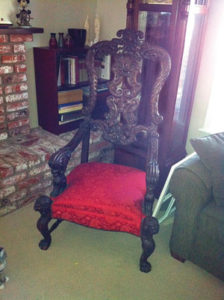
CP from Santa Barbara sends me a photograph of an ornate mahogany armchair with a carved and cartouche-crested top rail, a pierced and carved back splat and throne-like arms which terminate in seated lion caryatids, supported on lion-faced cabriole legs ending in hairy paw feet. Sounds like your mother in law right? Or a foreign language? This is the language Christies’ auction house in Manhattan taught me to describe antique furniture. This is how an auction catalogue reads. But most people don’t recognize the chair from those fancy words. So I’ll describe CP’s chair in another way. This chair comes across as overblown, heavy and hideous. The worth is about $200.
That said, the chair represents a style called Rococo Revival, which eminently became the most popular style of both furniture and architecture for 50-years from the 1850’s.
The Reason Behind the Styles Popularity
Napoleon III, the first president of France’s Second Republic who then crowned himself Emperor of France’s Second Empire. All the “Seconds” are because the First Empire belonged solely to his Uncle, Napoleon the FIRST. Napoleon III of the House of Bonaparte served as a reformer.
Interestingly, the current head of the House of Bonaparte exists today and is Jean-Christophe, the Prince Napoleon, who is a thirty-something investment banker in New York, and is a pretty fine looking male specimen.
I digress. His ancestor Napoleon III “redid” Paris, with the help of engineer Georges Eugene Haussmann. Take for example, my favorite, the Avenue de l’Opera, along with the Paris Opera House. In Paris in 1854, Haussmann and Napoleon III cut through centuries of old buildings to create 50-miles of new avenues, connected to the central parts of Paris. They designed all the new buildings in the Rococo Revival style, which they called the Second Empire style in France. All the grand buildings are the same height and design and are faced with the same cream limestone.
People considered Napoleon III’s style more grandly imagined than the classic French Empire style of his Uncle Napoleon I. All the world followed suit.
The spikily be-mustached Napoleon III and his Queen Eugenie led a glittering social life with lavish parties in these opulent spaces and surroundings. If it is French, it must be the last word in fashion, the world conjectured.
Thus CP’s Rococo Revival chair is very grand, very luxurious, very serious, very American, very aristocratic, and very un-popular today. CP’s chair tells us how classy the rear end of the sitter on it is. Rococo Revival spread from France to German (in a Louis XVI way), then to England, and then to the East Coast mansions of the robber barons of America, who felt en-nobled by anything French.
Rococo Revival style trickled down to the American middle class, especially those who ran dirty factories, and who came from nothing. They needed a chair such as CP’s to proclaim their aristocratic taste where none existed. A house should announce an occupant’s cultured character. You can only achieve this with, people believed, stylistic references to the past, because something used by a king indicates taste and gentility.
CL’s Rococo Revival chair dates from the 1860’s and was perhaps a part of a whole dining suite with many equally obnoxious dining chairs and a huge and ponderous heavy dining table with grandly carved lion heads as well. And horrors, perhaps even a matching sideboard, an America, coffin-like china closet. The concept screams “show grand, be grand.”
This belief still sits within our collective consciousness
Upon the birth of my son my assistant instructed me to get rid of the French style furniture in his first bedroom. She feared it might make him an effeminate spoiled monster. The furniture didn’t effect his character, but he definitely HATES antiques. He did his first house in what he calls “Minimalism.”